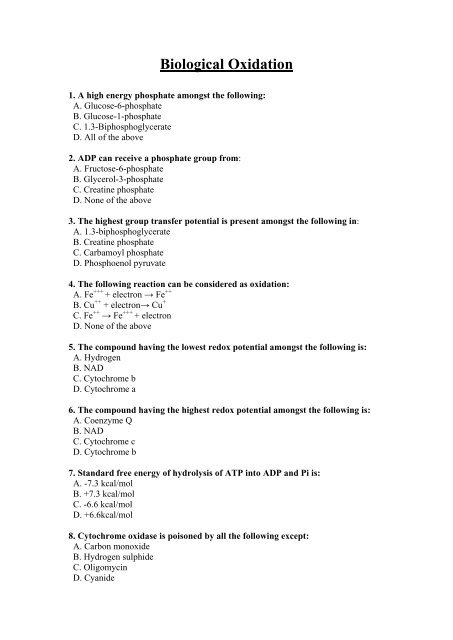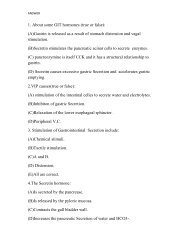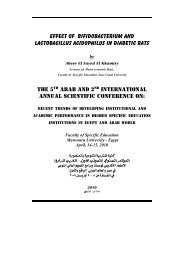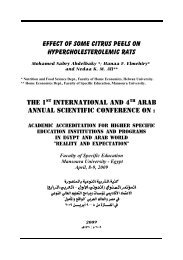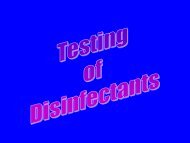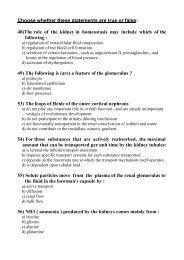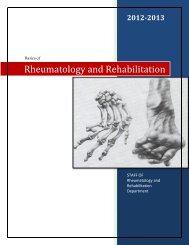2 nd MCQ (Biological Oxidation)
2 nd MCQ (Biological Oxidation)
2 nd MCQ (Biological Oxidation)
You also want an ePaper? Increase the reach of your titles
YUMPU automatically turns print PDFs into web optimized ePapers that Google loves.
<strong>Biological</strong> <strong>Oxidation</strong>1. A high energy phosphate amongst the following:A. Glucose-6-phosphateB. Glucose-1-phosphateC. 1.3-BiphosphoglycerateD. All of the above2. ADP can receive a phosphate group from:A. Fructose-6-phosphateB. Glycerol-3-phosphateC. Creatine phosphateD. None of the above3. The highest group transfer potential is present amongst the following in:A. 1.3-biphosphoglycerateB. Creatine phosphateC. Carbamoyl phosphateD. Phosphoenol pyruvate4. The following reaction can be considered as oxidation:A. Fe +++ + electron → Fe ++B. Cu ++ + electron→ Cu +C. Fe ++ → Fe +++ + electronD. None of the above5. The compou<strong>nd</strong> having the lowest redox potential amongst the following is:A. HydrogenB. NADC. Cytochrome bD. Cytochrome a6. The compou<strong>nd</strong> having the highest redox potential amongst the following is:A. Coenzyme QB. NADC. Cytochrome cD. Cytochrome b7. Sta<strong>nd</strong>ard free energy of hydrolysis of ATP into ADP a<strong>nd</strong> Pi is:A. -7.3 kcal/molB. +7.3 kcal/molC. -6.6 kcal/molD. +6.6kcal/mol8. Cytochrome oxidase is poisoned by all the following except:A. Carbon monoxideB. Hydrogen sulphideC. OligomycinD. Cyanide
9. L-amino acid oxidase contains:A. FADB. FMNC. NADPD. NAD10. All the following statements about L-amino acid oxidase are true except:A. It is a flavoprotienB. It transfers hydrogen atoms from its substrate to oxygen forming waterC. It contains FMN as prosthetic groupD. Its prosthetic group is tightly bou<strong>nd</strong> to apoenzyme protein11. Iron-porphyrin is present as prosthetic group in:A. CytochromesB. CatalaseC. PeroxidaseD. All of the above12. Enzymes which incorporate oxygen into a substrate are called:A. OxidasesB. DehydrogenasesC. OxygenasesD. Hydroperoxidases13. Microsomal hydroxylase system contains a:A. Di-oxygenaseB. Mono-oxygenaseC. OxidaseD. Hydroperoxidase14. A cytochrome present in microsomal hydroxylase system is:A. Cytochrome aB. Cytochrome bC. Cytochrome a 3D. None of the above15. Superoxide radicals can be detoxified by:A. Cytochrome cB. Cytochrome bC. Cytochrome aD. None of the above16. A copper containing cytochrome is:A. Cytochrome aB. Cytochrome P450C. Cytochrome a 3D. None of the above
17. At sites of phosphorylayion in the respiratory chain, the minimum differencein the redox potentials of two consecutive components is:A. 0.2 millivoltsB. 0.2 voltsC. 0.42 millivoltsD. 0.42 volts18. When reducing equivalents enter the respiratory chain through NAD the P:Oratio is:A. 1:2B. 2:1C. 1:3D. 3:119. Rate of tissue respiration is raised when the intracellular concentration of:A. ADP increasesB. ATP increasesC. ADP decreasesD. None of the above20. Cyanide inhibits phosphorylation at:A. Site ΙB. Site ΙΙC. Site ΙΙΙD. None of the above21. The following component of respiratory chain is not fixed in the innermitocho<strong>nd</strong>rial membrane:A. Coenzyme QB. Cytochrome cC. Both of the aboveD. Neither of the above22. F 0 component of vectorial ATP synthetase is inhibited by:A. DinitrophenolB. RotenoneC. CyanideD. Oligomycin23. Uncouplers of oxidative phosphorylation:A. Inhibit F 0 component of vectorial ATP synthetaseB. Inhibit F 1 component of vectorial ATP synthetaseC. Make the inner mitocho<strong>nd</strong>rial membrane permeable to H +D. Inactivate cytochromes24. Extramitocho<strong>nd</strong>rial NADH can be oxidized in the respiratory chain with thehelp of:A. Glycerophosphate shuttleB. Malate shuttle
C. Either of the aboveD. Neither of the above25. In some reactions, energy is captured in the form of:A. GTPB. UTPC. CTPD. None of the above26. Substrate-linked phosphorylation occurs in:A. Glycolytic pathwayB. Citric acid cycleC. Both of the aboveD. None of the above27. Reducing equivalents move in the respiratory chain from:A. Relatively electronegative to electropositive componentsB. Lower redox potential to higher redox potentialC. Reduced substrate to oxygenD. All of the above28. Hydrogen peroxide may be detoxified in the absence of an oxygen acceptorby:A. PeroxidaseB. CatalaseC. Both of the aboveD. Neither of the above29. All the following statements about hepatic microsomal hydroxlase system arecorrect except:A. It metabolites several drugsB. It contains cytochrome P-450C. It contains a flavoproteinD. It contains iron-sulphur protein30. Superoxide radicals can be detoxified by:A. Cytochrome cB. Superoxide dismutaseC. Both of the aboveD. Neither of the above


